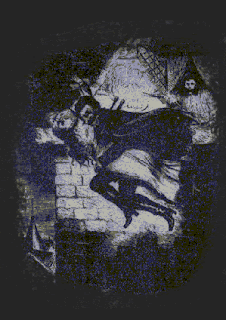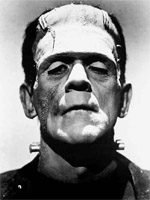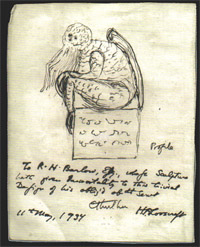
The Amityville Horror is probably one of the most documented and well known American ghost stories of its time. It had all the makings of a great horror story, a gruesome killing, a man in prison claiming demons or ghosts made him kill his own family, an innocent family is forced out of their home because of the demonic spirits and nearly everyone’s imaginations were ignited. Could there be an evil force living at 112 Ocean Ave? Was Ronald Defeo Jr. possessed when he killed his family? Were the Lutz family really driven from their home by malevolent spirits?
According to Jay Anson’s book:
On November 13, 1974 at 3am, Ronald ‘Butch’ Defeo Jr. finished watching a WWII movie called Castle Keep, in the second floor t.v. room. He then grabbed his .35 Marlin rifle and proceeded walk through the house and methodically shoot his mother, his father, two brothers and two sisters as they lay sleeping. The victims were all found face down on their beds with no trace of sedatives in their system, all of them shot in the back, except for Mrs. Defeo who was shot in the head. Mystery and intrigue surrounded the case and Ronald Defeo Jr. was arrested and tried for the crimes.
Ronald Defeo Jr. was later convicted of murder and sentenced to six consecutive life sentences which he is still serving today. He left behind many questions such as, why were the Defeos found in the same position? Why didn’t the children wake up or try to escape after hearing the first shots? Why didn’t the neighbours hear any shots fired? Last of all, what would make a person shoot his entire family?
According to Defeo, at the time, he claimed that "For months before the incident, I heard voices. Whenever I looked around, there was no one there, so it must have been God talking to me." His court appointed attorney, William Weber, pleaded insanity as a defence. Was there credence to his claims? Could something dark and sinister been at play in the Defeo household? The Lutz family was sure to find out.
On December 18, 1975, the Lutz family moved into the home and moved back out 28 days later. According to the book The Amityville Horror: A True Story by Jay Anson, these are the events that drove the Lutz family from their new home:
December 18, 1975: The Lutz family move into their new home at 112 Ocean Ave. They invite their priest, Father Pecoraro (Father Mancurro in the book) to bless their home. When Father Pecoraro begins his ritual and sprays the first bit of Holy water, he hears a male voice tell him to “Get out.” No one is there. When the priest leaves their home and arrives at his mother’s home, she tells him he looks awful. He looks in the mirror and sees his face is pale and there are dark circles under his eyes. Upon driving home, his car begins acting strangely, the hood flies up and his car stalls. He gets a ride home from a friend who later called him and told him his windshield wipers had started to swish back and forth rapidly after he had dropped him off. He hadn’t turned them on.
December 19-21, 1975: George Lutz wakes up at 3:15am to the sound of knocking and his dog barking outside. George looks out a window, sees a shadow by his boathouse and tells his dog to “get him.” He then tells his wife he’s going to go outside to investigate. She wouldn’t remember their conversation in the morning. When he checks outside he finds that the boathouse door is open and banging open and shut in the wind, even though George swears that he locked it.
Kathleen Lutz wakes up early and goes to the kitchen to make herself some coffee. She gets the sensation that she is being watched and turns to find her daughter, Missy, standing behind her. The girl tells her she wants to go home.
George cannot get warm and becomes obsessed with checking the furnace to see if it is working and feeding logs into the fireplace in order to get warm.
Kathleen and George become increasingly intolerant of their children’s behaviour and begin yelling at their children for minor things such as playing too loud. When the children put a crack in one of the windows of their playroom, the Lutz’s began beating their children with a strap and a wooden spoon. They did not believe in or use corporeal punishment before that night.
December 22, 1975: Kathy feels a presence in the kitchen, a woman, who embraces her and touches her hand reassuringly when she becomes stressed about getting her house together in time for Christmas. This trance is broken when the children call her upstairs to see that their toilet bowl has become lined with black sludge. She sends her son to get some cleaner from her bathroom, only to discover that their toilet bowl has also become lined with black sludge. There is also a sweet perfume smell in their bedroom and a smell of rotten garbage or sewage from their toilet.
They check their sewing room, which is next to their bathroom for the source of the smell and discover that one of the windows is completely covered with black flies. They cannot discover the source of the smell or where the flies could have come from. They open their windows to shoo the flies out and air out their house. The smells dissipate, most of the flies are gone but traces of the black sludge in the toilet bowls remain even after vigorous cleaning attempts from Kathy.
December 23, 1975: George awakes at 3:15am once again to a cold house. He goes downstairs and finds that their heavy front door has been torn open and is only resting on one hinge. Kathleen goes to check on her children and notices that they are all sleeping on their stomachs, something which Kathleen insists they never did before especially all of them at the same time. She also finds her crucifix hanging upside down in her closet.
Missy is humming to herself in her room while staring out a window. She wanders into the hall where she stops humming and enters the sewing room where she begins humming again. Her mother sees this and hears her rummaging around in the room and then sees her come back out into the hall where she stops humming and then back into her room where she starts humming again. When Kathy goes to check on Missy, the girl is sitting back on her rocking chair and staring out the window. Without looking, Missy stops humming and asks her mother “Mommy, is there such a thing as angels?”
December 24, 1975: Father Pecoraro’s illness becomes worse, his temperature supposedly running up to 104 degrees. He has a nagging suspicion about the house, particularly of the sewing room on the second floor. He recalls thinking of the word ‘evil’ but later attributes this to delirium caused by the fever. The nagging feeling continues and he calls the Lutz’s house to warn them.
?George still has not showered, shaved or gone to work since moving into the house. The window to the sewing room came open on its own and the houseflies were back. The boathouse door slams open even though everyone was inside.
December 25, 1975: Christmas day. While outside, George spots his daughter looking down at him from her window and sees a pig with red eyes standing behind her. Missy claims the pig is her imaginary friend who is named ‘Jodi’.
An unexplainable cold takes over the children’s playroom even though the radiator is hot.
December 26, 1975: Kathy feels the presence in the kitchen once again but this time, the perfume smell is so powerful, it almost suffocates her.
Kathleen’s brother’s wedding is today. $1,500 goes missing from her brother’s coat pocket while he is standing in their kitchen.
December 27, 1975: The Lutz’s Aunt Theresa, a former nun, comes for a visit. While on a tour of their home, she refused to enter the sewing room and the children’s playroom because of ‘bad feelings.’ She quickly leaves without staying for dinner, as she would normally do.
Kathleen enters a trance and seemingly levitates towards a shelf in the basement. Behind the shelf, she discovers a hidden room which was painted entirely red. When she tells George about it, he goes to investigate and claims to he saw a fleeting image of Ronald Defeo Jr. inside the room.
December 28-30, 1975: Kathy sees a lion statue, which she bought for her husband as a gift, move a few inches but she brushes it off to imagination. Later, George trips over the statue, injuring his leg. When he examined his leg, he discovered that his bruising looked like teeth marks, as if the lion statue had bit him.
Kathy hears the window to her sewing room open and close repeatedly but refused to investigate the sounds out of fear.
George begins to investigate the Defeo murders and the history of the house. He discovers that a tribe of Shinnecock Indians had used the land for the mad and the dying.
December 31, 1975: The Lutz’s financial problems are getting worse and George becomes convinced that there is a hidden fortune somewhere on the property.
Their two boys, Danny and Chris threaten to run away from home and become unruly.
After midnight, the Lutz’s see a demon’s face appear in their fireplace.
January 1, 1976: The Lutz’s are awakened by strong winds blowing through their house. All the windows have been opened except for the one’s in Missy’s room. Her room is extremely warm and her rocking chair was moving on its own. Kathy sees two red eyes staring through the living room window at her and when they checked outside for a possible intruder, they discovered hoof prints in the snow.
January 2-3, 1976: Father Pecoraro blesses the Lutz’s house from his church by saying a mass for them. Upon returning to his apartment, he discovers a foul odour in the air.
George finds that the red room also has a foul odour emanating from it. The stench is so strong that he vomits.
The lion statue, which was moved to the sewing room, has reappeared in the living room.
January 4-5, 1976: George wakes to the sounds of marching and drum beats coming from the first floor. As soon as he enters the first floor living room, the sounds stop. Upon returning to his bedroom, George finds Kathy levitating nearly two feet above their bed.
The next night, George wakes to the same sounds. This time when he checks the living room, he finds that their furniture has been moved to one side, as if for a party. The sounds also stop immediately.
January 6, 1976: George discovers that the front steps leading into his home were built over an old covered well.
A friend of Father Pecoraro’s gets a phone call warning him that if Father Pecoraro goes back to the house, he’ll die. George calls the Psychical Research Institute in North Carolina upon Father Pecoraro’s suggestion to have a scientific investigation conducted on the house.
January 7, 1976: George sees his wife’s face change into that of a 90 year old hag’s for a brief moment and Father Pecoraro tells them to leave the house.
Kathy’s coworker’s fiancé, supposedly a medium, visited the house. While in a trance, she tells the Lutzs to exorcise their house. George later finds that the second floor banister has been torn from its moorings.
January 8, 1976: Kathy’s brother and new sister-in-law are spending the night. The couple stayed in Missy’s room. At 3:15am, the sister-in-law begins screaming. A ghostly little boy had woken her up to ask where Missy and Jodi were. George and Kathy begin to bless their house on their own. As they attempted to bless their living room, the Lutz’s heard a loud humming sound which turned into a chorus of voices that said, “Will you please, stop?”
January 9, 1976: Green slime begins to ooze down the walls of the third floor hallway. George attempts to read the Bible aloud and was warned to stop by flames leaping out at him from the fireplace and what felt like an icy finger jabbing him in the back. He then discovered that all of the windows in the children’s bedrooms had opened again by themselves. All of the Lutzes sleep in the master bedroom that night.
January 10, 1976: Kathy’s mother comes over to examine some welts that had formed on Kathy’s body. She tried to convince Kathy to live with her.
Danny is injured when a window slams closed onto his hand and is taken to Brunswick Medical Hospital.
All of the windows and doors on the third floor were found smashed and open but none of the Lutzes heard any glass breaking.
January 11-12, 1976: George gets a call from a field investigator from the Psychical Research Institute in North Carolina named George Kekoris. Mr. Kekoris informs George that he would like to visit the house and spend the night sometime soon.
Father Pecoraro is told by his bishop to distance himself from the Lutz case.
Missy tells her mother that Jodi told her that she will live in the house forever to play with the lost soul of a little boy.
The marching band once again starts up at 3:15am but George refuses to leave his bed to investigate.
January 13, 1976: The Lutzes attempt to flee the home but were forced to stay due to car troubles and a violent storm. The electricity and phones had gone out because of the storm and although the oil burner was out, the temperature in the house strangely rose to 90 degrees before dropping drastically to 60 degrees. The green slime returns, oozing from the playroom’s broken lock.
Since they were unable to leave, the Lutzes went to sleep. The boys claim to have seen a monster in their room that night.
January 14, 1976: George sees a demonic image, the same as the one he saw in the fireplace, point at him from the third floor. Leaving all of their valuables behind, the Lutzes finally flee 112 Ocean Avenue forever.
The question remains, what really happened in the months the Lutzes lived at 112 Ocean Avenue? Were they the victims of a tragic and horrifying haunting brought on by murder? Or were they the perpetrators of an elaborate hoax designed to bolster Ronald Defeo Jr.’s insanity plea?
Author Ric Osuna believes that the only horror that occurred in Amityville was the tragic death of an entire family and that the Lutzes story is nothing but a hoax. For an in depth look at his research, please feel free to visit his site:
The Amityville Murders
Fact or Fiction, The Amityville Horror remains one of the most prominent and engaging ghost story of its time.














